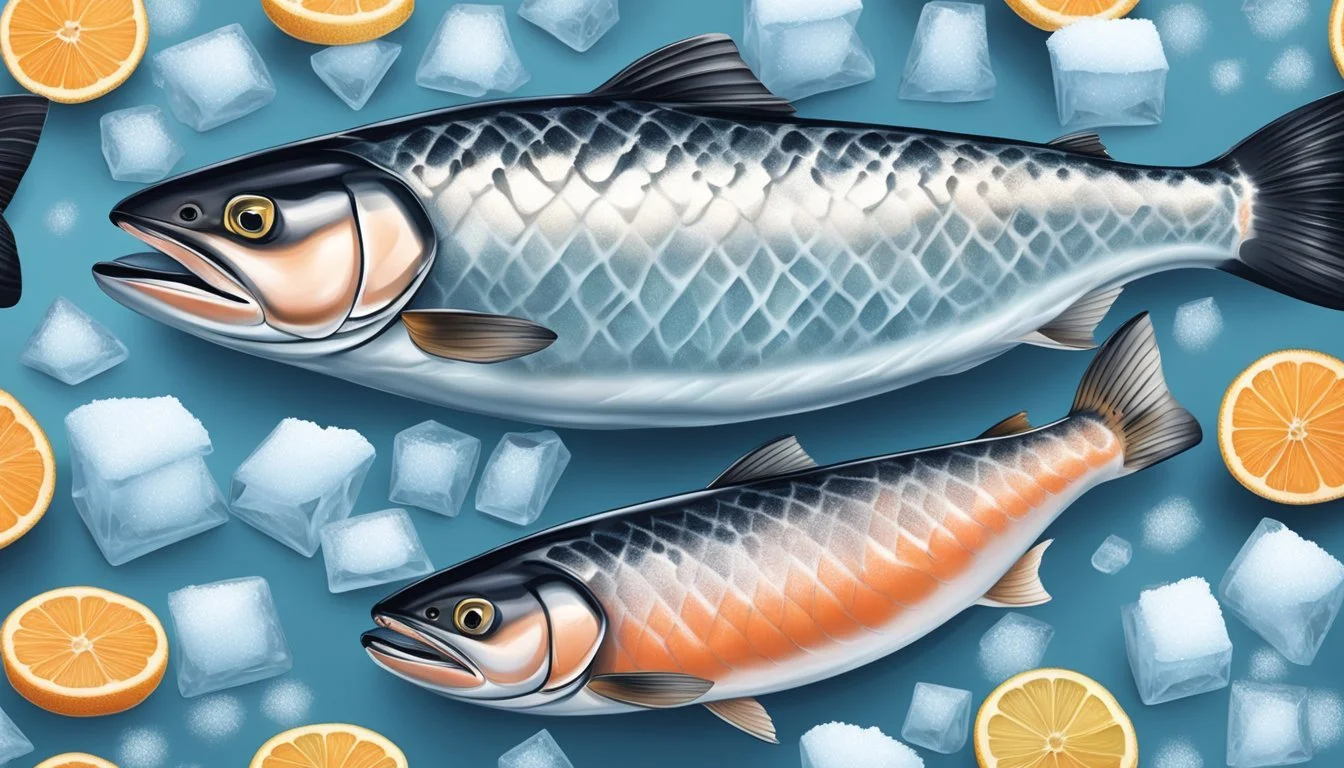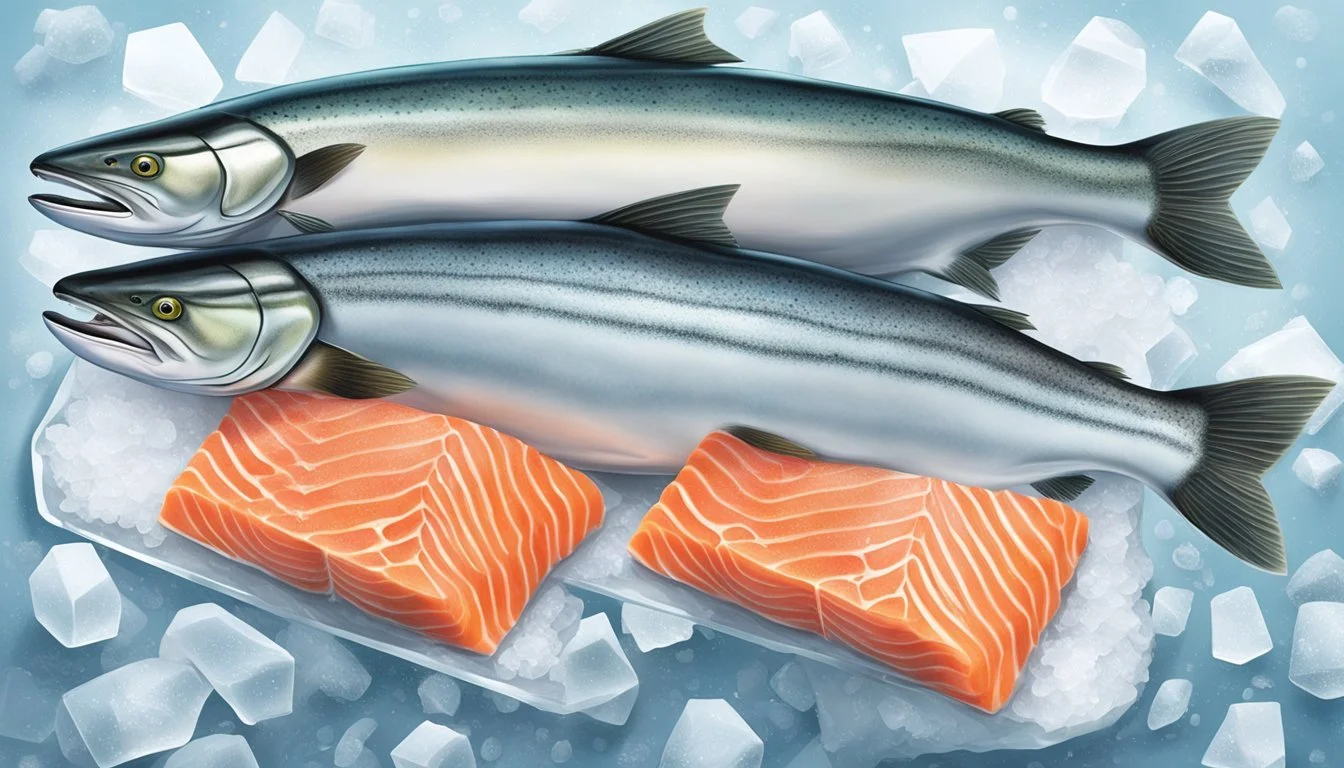Fresh vs Frozen Salmon: Comparing Quality, Taste, and Nutritional Value
When it comes to choosing salmon, consumers often face the dilemma of fresh versus frozen. Both options have their merits, and understanding the differences can help make an informed decision.
Fresh salmon is prized for its firm texture and delicate flavor. It's often considered the superior choice for its perceived quality and taste. Both fresh and frozen salmon can be equally nutritious and delicious when handled properly. Frozen salmon, when flash-frozen shortly after catching, locks in the fish's goodness, preserving its taste, texture, and nutritional value.
The choice between fresh and frozen salmon often depends on factors such as availability, convenience, and intended use. Fresh salmon may be ideal for immediate consumption, while frozen offers flexibility in storage and preparation. Ultimately, the quality of the salmon, regardless of its form, is influenced by factors such as the fishing method, processing techniques, and handling throughout the supply chain.
Understanding Salmon
Salmon is a popular fish known for its vibrant color and nutritional benefits. It comes in various species and forms, each with unique characteristics and health properties.
Types of Salmon
Several salmon species are commonly consumed. Atlantic salmon is widely farmed and has a mild, delicate flavor. Pacific salmon includes varieties like sockeye, known for its deep red color and rich taste. Chinook or king salmon is prized for its high fat content and buttery texture.
Wild-caught salmon is harvested from natural habitats, while farmed salmon is raised in controlled environments. Wild salmon typically has a more intense flavor and firmer texture. Farmed salmon is more readily available year-round and often more affordable.
Nutritional Profile of Salmon
Salmon is a nutrient-dense food, packed with essential vitamins and minerals. It's an excellent source of high-quality protein, providing all essential amino acids.
One of salmon's most notable nutritional attributes is its high content of omega-3 fatty acids, particularly EPA and DHA. These fatty acids support heart and brain health.
Salmon is rich in potassium, which aids in blood pressure regulation. It also contains selenium, an important antioxidant. The fish provides iron, crucial for oxygen transport in the body.
Vitamins found in salmon include B12, essential for nerve function and blood cell formation. It also contains vitamin D, vital for bone health and immune function.
Fresh Salmon Explained
Fresh salmon offers distinct qualities in terms of flavor, texture, and nutritional value. It provides numerous health benefits and requires careful selection to ensure optimal freshness.
Characteristics of Freshness
Fresh salmon displays several key indicators of quality. The flesh should be firm and springy to the touch, with a vibrant pink or orange color. When pressed, the flesh should bounce back quickly. The skin should be shiny and moist, without any discoloration or dryness.
Fresh salmon has a mild, clean scent reminiscent of the ocean. Any strong fishy odors indicate the salmon is past its prime. The eyes of whole fish should be clear and bulging, not cloudy or sunken. Gills should be bright red or pink, not brownish or slimy.
When purchasing fresh salmon, look for cuts with minimal gaping between the muscle fibers. This indicates the fish has been handled properly and maintains its structural integrity.
Benefits of Fresh Fish
Fresh salmon offers a superior taste experience. It has a delicate, clean flavor that allows the natural richness of the fish to shine through. The texture is typically firmer and more succulent compared to frozen options.
Fresh salmon retains its full nutritional profile. It's an excellent source of high-quality protein, omega-3 fatty acids, and vitamins D and B12. These nutrients support heart health, brain function, and overall well-being.
The versatility of fresh salmon allows for various cooking methods. It can be grilled, baked, poached, or even served raw in sushi preparations. This flexibility makes it easy to incorporate into diverse meals.
Fresh salmon often has a shorter supply chain, potentially reducing the environmental impact of transportation and storage. However, availability may be limited by seasonality and geographic location.
Frozen Salmon Deep Dive
Frozen salmon offers unique advantages in preservation and convenience. This method locks in freshness and extends shelf life while maintaining nutritional value.
Freezing Process
Flash-freezing is the preferred method for freezing salmon. It rapidly brings the fish temperature down to -40°F (-40°C) or lower. This quick freeze prevents large ice crystals from forming, which can damage cell walls and affect texture.
Commercial freezers use blast freezing or cryogenic freezing techniques. These methods freeze salmon within hours of catch, preserving its peak freshness. At home, placing salmon in the coldest part of the freezer helps maintain quality.
Proper packaging is crucial. Vacuum-sealing or wrapping tightly in plastic and foil prevents freezer burn and oxidation.
Quality Preservation
Frozen salmon can maintain high quality for 3-8 months when stored at 0°F (-18°C) or below. Proper freezing preserves nutrients, including omega-3 fatty acids and protein content.
Thawing methods impact quality:
Refrigerator: Slow but safest
Cold water: Faster, requires sealed packaging
Microwave: Quick but can partially cook edges
Frozen salmon may have a softer texture than fresh due to ice crystal formation. However, when handled correctly, flavor differences are minimal.
Benefits of frozen salmon:
Extended shelf life
Convenient year-round availability
Often cheaper than fresh
Can be frozen at peak freshness
For best results, use frozen salmon within recommended timeframes and avoid refreezing previously-frozen fish.
Comparison of Fresh vs Frozen
Fresh and frozen salmon offer distinct characteristics in taste, texture, nutrition, convenience, and cost. These factors influence consumer choices and culinary applications.
Taste and Texture
Fresh salmon typically provides a more vibrant flavor profile. Its flesh is firm and moist with a delicate taste. Wild-caught fresh salmon often exhibits a deeper, more complex flavor than its farmed counterparts.
Frozen salmon can maintain much of its original taste when properly handled. Flash-freezing techniques help preserve flavor compounds. Upon thawing, frozen salmon may have a slightly softer texture compared to fresh.
High-quality frozen salmon can rival fresh in taste, especially if frozen shortly after catch. Proper thawing is crucial to maintain texture - gradual defrosting in the refrigerator yields better results than rapid thawing methods.
Nutritional Differences
Both fresh and frozen salmon offer similar nutritional benefits. They are rich sources of omega-3 fatty acids, protein, and essential vitamins like B12 and D.
Fresh salmon may have a slight edge in nutrient retention immediately after catch. However, flash-freezing can effectively lock in nutrients, preserving them for extended periods.
Frozen salmon can maintain its nutritional value for several months when stored properly. This stability makes it a reliable source of omega-3s and other nutrients year-round.
Some studies suggest minimal differences in omega-3 content between fresh and frozen salmon. Both forms provide comparable health benefits when consumed as part of a balanced diet.
Convenience and Availability
Frozen salmon offers unparalleled convenience. It can be stored for months, allowing for spontaneous meal planning. Pre-portioned frozen fillets simplify preparation and reduce waste.
Fresh salmon requires more immediate use, typically within 1-2 days of purchase. It demands careful storage and prompt cooking to maintain quality.
Frozen salmon is widely available year-round in most supermarkets. This consistency makes it a reliable option for regular consumption.
Fresh salmon availability may fluctuate with seasons and fishing conditions. Wild-caught varieties, in particular, have limited seasonal availability in many regions.
Cost Comparison
Fresh salmon, especially wild-caught varieties, often commands premium prices. Seasonal availability and transportation costs contribute to higher price points.
Frozen salmon is generally more affordable. Bulk purchasing and longer storage life allow for cost savings. Sales and promotions on frozen salmon are more common, offering additional value.
Price fluctuations are less pronounced with frozen salmon due to consistent supply. Fresh salmon prices may vary significantly based on market conditions and seasonality.
Value considerations extend beyond price. Fresh salmon's premium taste may justify higher costs for some consumers. Frozen salmon's long shelf life and reduced waste can provide better overall value for others.
Proper Handling and Storage
Proper handling and storage techniques are crucial for maintaining salmon quality and safety. These methods help preserve freshness, prevent spoilage, and ensure the best possible flavor and texture.
Thawing Techniques
Thawing frozen salmon correctly is essential for food safety and optimal taste. The safest method is to move the frozen salmon from the freezer to the refrigerator. This slow thaw allows for even defrosting and helps maintain moisture content.
For quicker thawing, place the sealed salmon in cold water. Change the water every 30 minutes to ensure consistent temperature. Never thaw salmon at room temperature, as this can promote bacterial growth.
Microwave thawing is the fastest option but can lead to uneven heating. Use the defrost setting and check frequently to avoid cooking the edges.
Storage Tips
Proper storage extends salmon's shelf life and maintains its quality. Fresh salmon should be stored in the coldest part of the refrigerator, typically the bottom shelf.
Wrap the salmon tightly in plastic wrap or aluminum foil to minimize air exposure. For best results, use vacuum-sealed bags to prevent freezer burn when freezing.
In the refrigerator, fresh salmon lasts 1-2 days. Frozen salmon can be stored for 9-12 months in the freezer at 0°F (-18°C).
Label packages with the date of purchase or freezing. This practice helps track freshness and ensures timely use.
When storing cooked salmon, cool it quickly and refrigerate within 2 hours to prevent bacterial growth.
Cooking with Salmon
Salmon offers versatile cooking options, whether using fresh or frozen fillets. Different methods can enhance its flavor and texture, creating delicious meals.
Preparing Fresh Salmon
Fresh salmon requires minimal preparation. Rinse the fillet under cold water and pat dry with paper towels. Remove any pin bones using tweezers. For added flavor, season with salt, pepper, and herbs.
Grilling fresh salmon creates a smoky taste. Brush the fillet with oil to prevent sticking. Cook for 4-5 minutes per side on medium-high heat. Pan-searing offers a crispy exterior. Heat oil in a skillet over medium-high heat. Cook skin-side down for 3-4 minutes, then flip and cook for 2-3 minutes.
Baking is a foolproof method. Preheat the oven to 400°F (200°C). Place the seasoned fillet on a baking sheet and cook for 12-15 minutes. Poaching keeps the fish moist. Simmer in a flavorful liquid for 8-10 minutes until opaque.
Cooking Frozen Salmon
Frozen salmon can be cooked without thawing, though defrosting often yields better results. To defrost, place in the refrigerator overnight or use cold water for quicker thawing.
When cooking from frozen, add about 50% more cooking time. For baking, preheat the oven to 425°F (218°C). Cook for 15-20 minutes. Pan-frying requires lower heat to prevent overcooking the exterior. Cook for 6-8 minutes per side.
Poaching works well for frozen fillets. Simmer in liquid for 10-12 minutes. Grilling frozen salmon can be tricky. It's best to partially thaw first, then grill over medium heat for 6-8 minutes per side.
For all methods, use a meat thermometer to ensure the internal temperature reaches 145°F (63°C). Serve with lemon wedges or a flavorful sauce to enhance the culinary experience.
Selecting the Best Option
When choosing between fresh and frozen salmon, quality and source are key factors to consider. Evaluating these aspects carefully and making informed purchases will help you select the best option for your needs.
Evaluating Quality and Source
Look for bright, firm flesh when selecting fresh salmon. Clear eyes in whole fish indicate freshness. For frozen salmon, check for proper packaging without ice crystals or freezer burn. Wild-caught Alaskan salmon is prized for its quality and sustainability. Farmed salmon can be a good choice if raised responsibly.
Consider the source - reputable fishmongers often have the freshest options. Grocery stores may offer convenience but vary in quality. Ask where and when the fish was caught or harvested.
Making Informed Purchases
Compare prices between fresh and frozen options. Frozen salmon is often more affordable and has a longer shelf life. Fresh salmon should be used within 1-2 days of purchase.
Think about how you'll use the salmon. Fresh is ideal for raw preparations like sushi. Frozen works well for cooking methods like grilling or baking.
Match your choice to individual preferences. Some prefer the flavor and texture of fresh, while others find high-quality frozen equally satisfying. Consider family size and eating habits when deciding between whole fish, fillets, or portioned cuts.
Environmental Impact and Sustainability
Salmon production methods have varying environmental impacts. Wild-caught salmon generally has a lower environmental footprint when harvested sustainably from well-managed fisheries.
Farmed salmon can have significant impacts on surrounding ecosystems. These include water pollution from excess feed and waste, as well as potential spread of diseases to wild populations.
Aquaculture practices have improved in recent years. Some salmon farms now use closed containment systems to reduce environmental risks. Others have adopted more sustainable feed sources and reduced antibiotic use.
The carbon footprint of farmed salmon (2.9 kg CO2 equivalent per kg of edible product) is much lower than that of beef (up to 30 kg CO2e/kg). This makes salmon a more climate-friendly protein option.
Sustainability certifications like the Marine Stewardship Council (MSC) help consumers identify responsibly sourced wild salmon. For farmed salmon, look for certifications from organizations like the Aquaculture Stewardship Council (ASC).
Preservation method (fresh vs. frozen) has minimal impact on sustainability. The main environmental considerations relate to production methods and transportation distances.
Choosing sustainable salmon supports healthy marine ecosystems. It also helps ensure continued availability of this nutritious fish as part of a balanced diet.
Health and Nutrition Considerations
Salmon offers numerous health benefits, whether fresh or frozen. Both forms provide high-quality protein and omega-3 fatty acids, which support heart health and brain function.
Freezing does not significantly reduce the nutritional content of salmon. The protein, fat, and fat-soluble vitamins like A and D remain largely unaffected by the freezing process.
Fresh salmon typically contains slightly higher levels of B vitamins and minerals. However, the difference is minimal and unlikely to impact overall health outcomes.
Frozen salmon can be a cost-effective way to incorporate this nutritious fish into one's diet regularly. It allows for longer storage and reduces food waste.
Both fresh and frozen salmon are excellent sources of vitamin D, which is crucial for bone health and immune function. A 3-ounce serving provides about 50% of the recommended daily intake.
The omega-3 fatty acids in salmon help reduce inflammation in the body. This can potentially lower the risk of chronic diseases such as heart disease and certain types of cancer.
Salmon is low in saturated fat, making it a heart-healthy protein choice. Replacing red meat with salmon in meals can contribute to improved cardiovascular health.
Essential vitamins found in salmon include B12, which is vital for nerve function and the production of red blood cells. Both fresh and frozen varieties provide this important nutrient.




